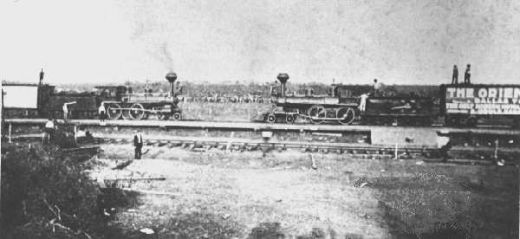Hey, Let’s Crash Two Trains Together!

But before 1901, Texas simply was not as densely populated. It did, however, have a number of railway lines running through it, including the Katy — officially, the Missouri-Kansas-Texas Railroad.
A man by the name of William George Crush was the general passenger agent for the Katy, and he was charged with making sure that the railroad had enough passenger business to warrant its ongoing operation. Crush, seeking visibility, came up with an idea. Train wrecks, he observed, always seemed to attract large crowds — so Crush decided to create a train wreck of his very own.
The train wreck was to occur on September 15, 1896, in a made-for-the-event “town” called Crush, Texas, located not too far from Waco. Admission to the event was free, and the railroad company offered tickets to Crush from anywhere in Texas for the bargain price of $2. Forty thousand people showed up to view the contrived accident. Two locomotives were placed on opposite ends of a four mile track. Their crews set them in motion and abandoned the engines, letting these two hulking machines speed at each other, unmanned at speeds approaching 45 miles per hour each. Disaster followed.
The trains collided into each other as planned, but — and this was not part of the plan — their boilers exploded. Debris flew into the crowd, killing three spectators and injuring untold others, including a photographer hired by the railroad (he lost an eye). Crush was immediately fired.
He was then hired back the next day, as apparently the catastrophe garnered little in the way of negative publicity.
Bonus fact: In 1901, Texas passed a law which made railroad companies liable if certain types of weeds (in the case that follows, Johnson grass) encroached upon nearby properties. A farmer named Clay May, pursuant to this statute, obtained a penalty payment from the Katy railroad for one such encroachment. Rather than pay the penalty, the company litigated the question — all the way to the United States Supreme Court. In 1904, the Court heard the case and ruled in favor of May. (Wikipedia sums up the legal issues in the case here.) Katy therefore had to pay the penalty: $25.
From the Archives: Thomas the Tank Engine’s Unlikely Friend: A odd juxtaposition of children’s media and grown-up humor — all involving a very useful train engine.
Take the Quiz: Plane, train, or automobile?
Related: A model train set — in case you want to have less dangerous train crashes.

Leave a comment